
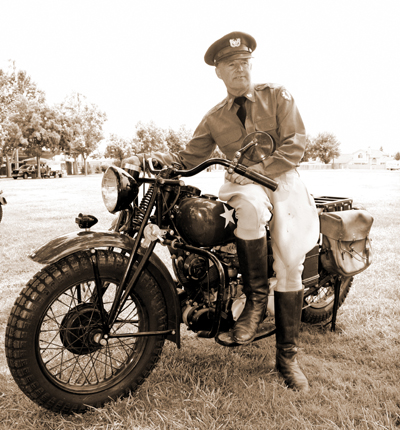
They said the Shovelhead was dead. They said the Evo's and TC's would always beat Shovels. They said you were wasting your time trying to build a fast Shovel.Good news.They were wrong!
Mike Sorensen spent his youth growing up on the family farm in Saskachewan Canada. He got into hotrods as a kid, just like most of us. Turns out, Mike was pretty good at making Detroit iron perform. So one day, Mike was trying to sell-off a 6-71 blower and was offered a trade for a '75 Sporty. Wanting to get into Harleys, Mike took that trade, and with that, our SORENSEN CHOPPERS story began.
The Sportster wasn't in the best of conditions, having spent the last 10 years fighting the weather rather than being cared for. In the end, Mike had to rebuild the entire bike. The cherry had been popped.
Not being one to go half way, Mike (who has a degree from BYU) enrolled in and completed a Harley-Davidson course in Alberta, receiving his “Harley papers.” Now the real fun kicked off.
Mike's first real project bike was born from his desire to build a Shovelster. Picking up a top end from his cousin, Mike started the project with only the basic notion of what he wanted to do. Mike had a couple pictures off the Internet, hand tools and one old mill. Needless to say the motor was put together and taken apart many times before it was completed. He even built a custom frame for his masterpiece. But the part that interests us today, is this bike was the first test bed for the heads we see today. It produced 94HP and 110Ft/lbs of torque. But Mike was personally kind of disappointed with the performance parts available. That's where Sorensen Performance gets its start.
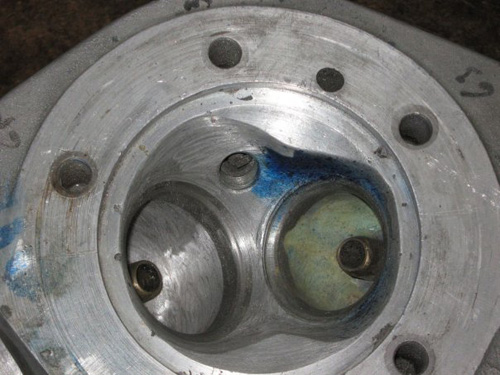
The following is a partial interview with Mike. We are talking about how he came up with the idea, and then developed the heads.
Rebel: Mike, this all had to start somewhere. So where is that exactly?
Mike: This is where it all started, the original heads.
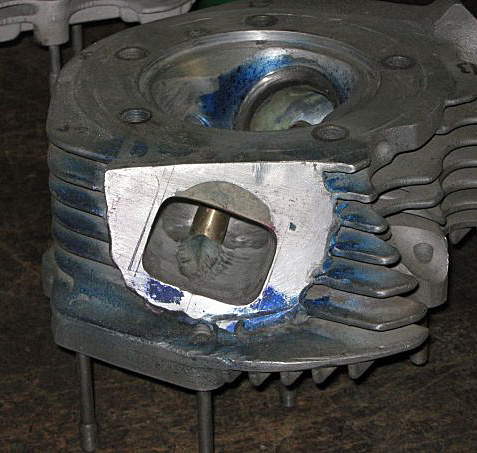
I decided I wanted to shrink the combustion chamber as much as I could and in doing so I wanted to swirl shit around as much as I could. So I went with a figure 8 chamber and then whammed in 30 degree squish bands to really slam it in there.
First the chamber was all done with clay, getting a rough shape then flow testing. Take a sharp tool and shave .020 at a time, flow test and on and on. Then spraying machinist's dye at various lifts to see how the pattern was.
Rebel: You're talking the air pattern around the valves?
Mike: Yes, and how it comes into the chamber too. Once I was happy with it, I welded up the chamber, and then recreated by hand what I did with clay. Then I started playing in the ports, As you can see by the epoxy in the exhaust port (See picture 1 above).
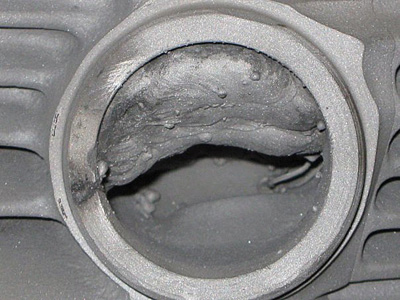
The intake opening is still an idea that I'm working on, but no time to finish. It's a true raised port by half an inch and flows 300cfm @650 lift with a 2-inch valve. I'm not sure if it will ever see production or not. I will be molding a billet head to run eventually. Flow potential here is high! But then the fun is getting an intake to fit and work, perhaps with a bolt-on style, and a paper gasket like a car.
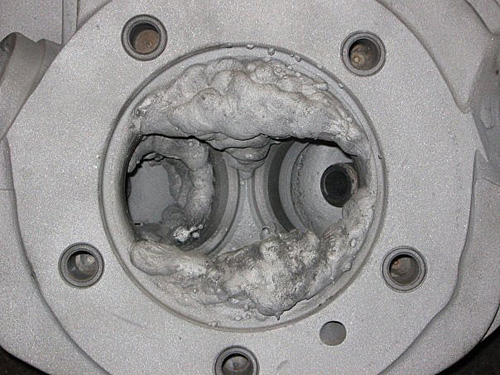
After I did all this, then I decided it's time to try it out. That's when I yanked the heads off the Shovester, broke out the MIG and grinder and went to town. She was the first, and it worked great.
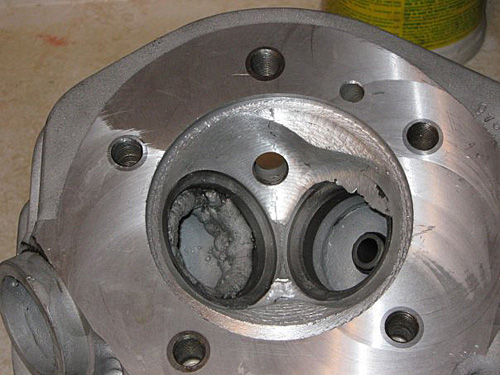
Rebel: Mike, take me through the development of the heads, from the Shovelster to today.
Mike: Ok, so I decided, there has to be something better. I looked and thought I'll try STD heads.So, I bought my first set of STD heads with a closed chamber and I paid to have them ported by STD.
I wanted to see what they were doing. After I got the heads, I put them on the flow bench and they flowed 240cfm. I was like WTF is this. They advertise 270! So then I started to get a lesson that the intakes were shit. I pissed around with the intake and still all I could get was 240cfm. Now I was really pissed!
So, I got the velocity probes in and started poking around and was like hmm. I pulled out the clay and built up the short turn and bang they jumped to 260 and smoothed out. The short turns were shit right from STD and they knew it. I phoned and bitched and sent them back.
They welded them up and then wanted to charge me! I just about lost my mind because with shipping back and forth and all that, I was into those heads for 2000cdn for bare castings. I got them back and they still only flowed 258. So, I had to sit down and figure why they wouldn't flow air. Basic design flaws is what I found.
I bitched to STD and they said, maybe they would fix the core box. They wanted to see a dyno sheet, so I showed them a dyno sheet. All of a sudden after that, my ads and the magazine article came out, and they didn't want to do any more business. Not one to give up that easy, I went with plan B, which I had in my head in the first place. Billet heads. This allowed me to fix all the bad shit. No fins, bad valve angles, no decompressors, shitty chambers, the STD inserts that fall out.
Their comment was, “It's a shovel who cares? Owners should be happy with 80hp.” That really left a bad taste in my mouth. It was just too much work to fix their designs. Crappy material, raising the port floor…
And now, here we sit today a head that is way ahead of anything on the market for Shovels, and on par with the Evo and TC heads.
Rebel: So the original plan was to use cast STD heads, with your modifications?
Mike: Yes, until I could make enough money to do billet or have my own cast. Every STD head needed massive porting and I just wasn't so keen on that, because by the time I was done I'd make about $300 profit on the heads after 4 or 5 days solid work. That wouldn't work.
Rebel: OK, so you were planning on producing the heads all along?
Mike: I just wanted to use STD to get rolling, but as I discovered I had some massive amounts of work ahead of me.
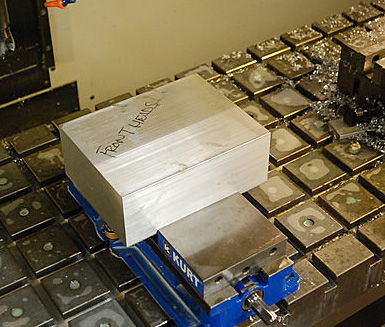
Rebel: Then you realized the only way it was going to work was a billet ground up effort. How did you proceed? Did you know Gordy? (Gordy owns the machine shop where the heads are actually cut from billet blocks). Tell us a little about transferring it from your mind to SolidWorks. I understand you built a flow bench model and then that got digitized. Is that right?
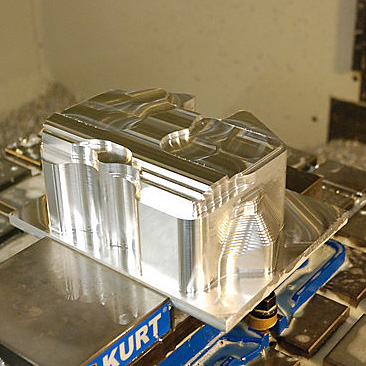
Mike: Yes, I phoned Gordy, but I didn't really have the money. But since STD didn't wanna do business, I thought fuck you, you cock suckers. I'll show you. So I phoned Gord and said let's do it. I had a set of raised port heads from STD that were sent with unfinished ports. They were raw and tiny, so I sat down and kept the cross section and the bowl as small as possible. I slowly just kept opening a little at a time until they flowed 280cfm. Then I sent them to be measured and digitized.
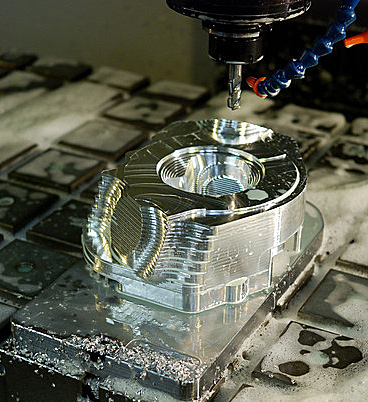
Once I had that in SolidWorks, I started making all the changes. Fins, valve angles, intake opening, upper fin area, decompressors. And then of course they had to scan the ports, and finish that. Then the heads were made. I still hand blend all the CNC marks out of every port and blend the seats in so everything is perfect. On heads where the guys want max power, I do a couple tiny chamber mods that help the airflow a little better on the lower lifts.
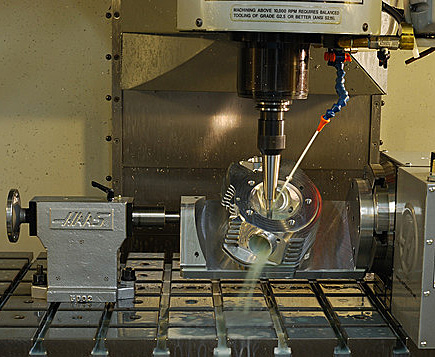
Rebel: How many hours to you figure you put into a set of heads after it's machined from a billet block.
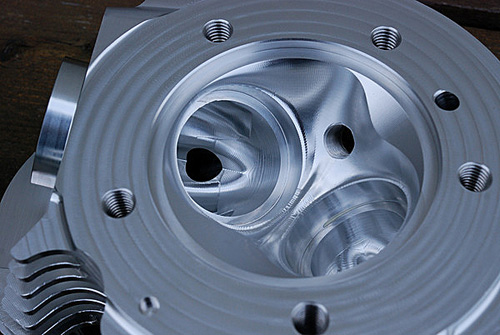
Mike: Probably 12 or so hours. I make all the valves by hand (from Evo valves). Then machine the grooves, trim to length, machine the seats to the right throat size, modify the Evo guides, then put her together. I hand blend, then perform a valve job, then blend the valve job, so it's perfect. I trim the guides for .410 seals, assemble and then they are ready to roll.
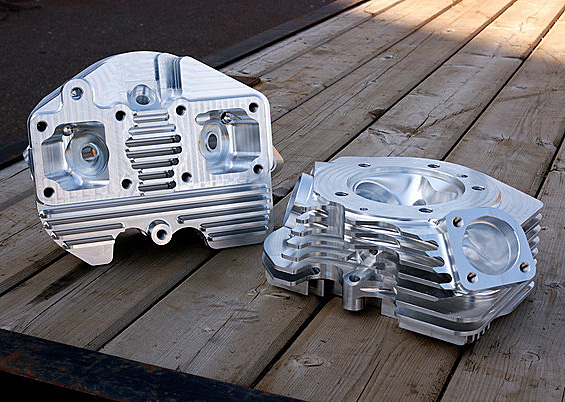
Rebel: Standard heads got up to what 3 5/8-inch? Then you redesigned to go bigger?
Mike: No, you can only max STD heads to 3 13/16-inch. Our new SP heads are designed for 4-inch and up, with a big port that uses a regular cam.
Rebel: You also designed an Evo cam conversion setup. Tell me about that.
Mike: Yeah, I have an Evo conversion kit. We straightened out the angles more over the competition's and use nice tighter clearances of .0011, compared to the competition's worn out specs of .0018. That allows the lifter to really rock in the bore with a big cam and heavy spring pressure. I tested the competition's blocks and they showed severe side loading and wear in a very short time, compared to the SP blocks that are tighter and hold the lifter steadier, and show little signs of any wear even after severe beating on the dyno.
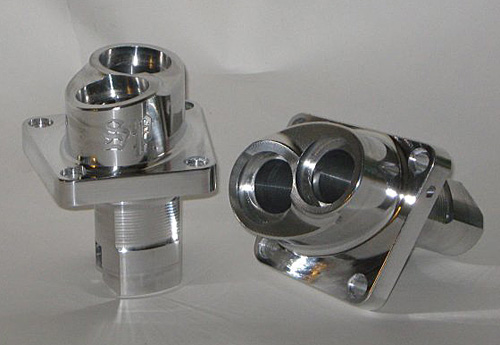
Rebel: Nice, you've developed a big bore billet cylinder too haven't you, for that 4 inch monster?
Mike: Yes, I wanted to offer a big bore cylinder with internal oiling.
Rebel: No one else manufacturers them?
Mike: There is almost zero mark up in them, but I'm the only one with big bore cylinders with internal drains. All my stuff runs internal drains, and they run way cooler than cast. I've built those more to help people out and give the market an option other than Axtel (they are forced to run external drains. My 4.250-inch barrel is designed to bolt right on any Evo bottom end. That allows super easy building of a big inch shovel.
Rebel: Are those available now?
Mike: They are still in production. Should be completed and in stock in the next couple of weeks (as of Nov 4th, 2009).
Rebel: Where do you get the liners?
Mike: They are CNC machined by LA Sleeve. Each set is custom ordered.
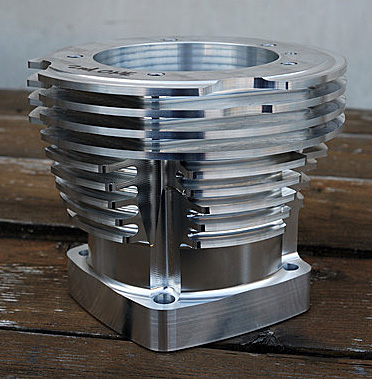
Rebel: How do you install them? Pressed?
Mike: They have a special step so they won't drop and are press fit into the barrels. If you used a straight sleeve they could drop into the motor over time. My barrels are made for rebuilding. You'll never buy another set of barrels. When you wear them out you press in a new sleeve and away you go again.
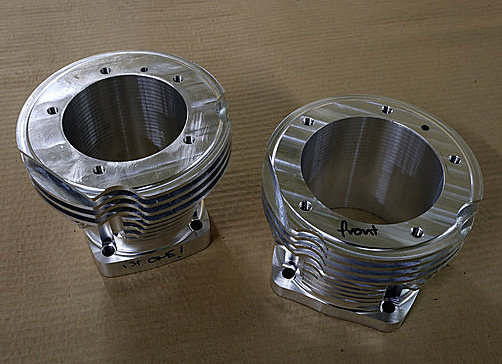
Rebel: OKay Mike, last thing. I'll bet you designed some killer rockers for Shovelheads. Tell me about them?
Mike: I wanted a rocker that was better than anything on the market, and I feel that the cast stuff is very over priced for what you get. Midwest is a very good indicator of that so we decided to go with a CNC machined piece of solid chromemoly material. The other rockers also suffer from torsional twist, so we added in little ribs of material to make the rocker as rigid as possible. After several hundreds of dyno runs they still look like new. I also used a little bigger roller from Scorpion Performance for better contact patch.Every rocker is drilled for top end oiling as well.
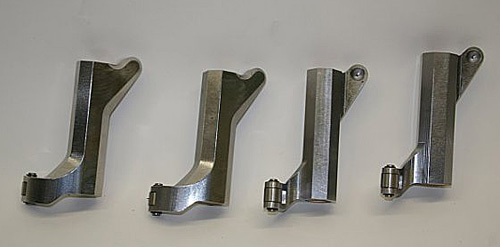
Rebel: Thanks for taking the time to tell us all about your work with SP. That's some exciting stuff for Shovelhead fans.
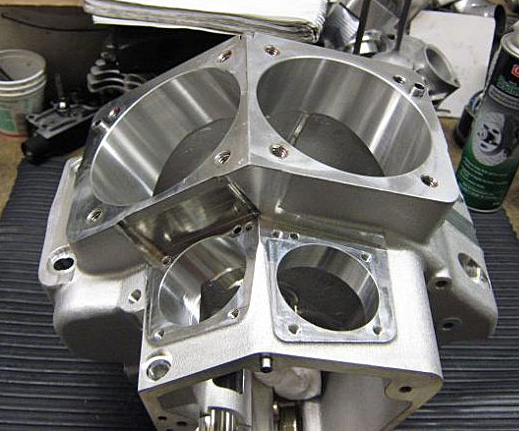
The last thing I thought I'd leave you with is Mike's current project. It's a 127-inch Shovelhead motor using an Ultima bottom end. The motor features SP billet cylinders, SP billet heads (the larger ones!), Evo cam, lifter blocks also from SP, SP roller rockers, and each motor is dyno'd and ready to install when it arrives. Pricing isn't final yet, but somewhere around $9,500 seems pretty fair. These babies are going to be in the 130 to 140 RWHP range. If that's not enough, there's always NOS! But you better be ready to strap yourself to the seat!
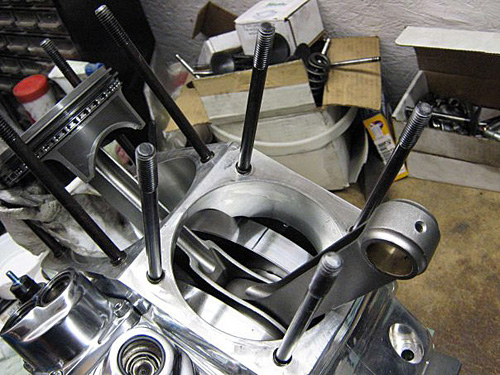

Mike was hard on STD, and they are currently out of business. But shortly they will be back, and Bikernet will bring you their new and improved story.–Wrench
